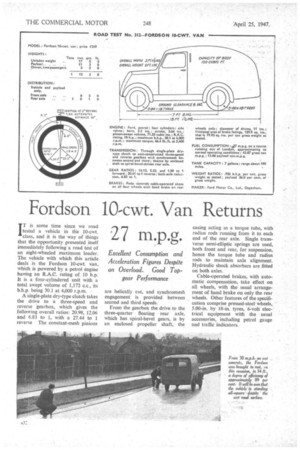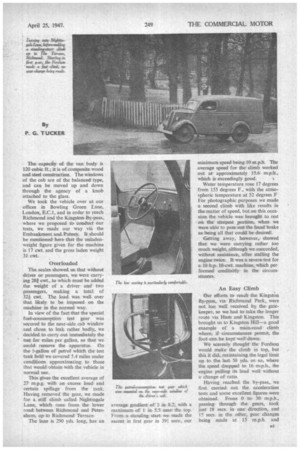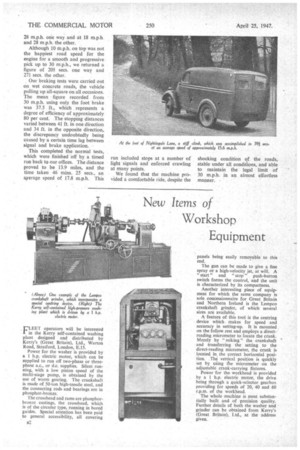Fordson 10-cwt. Van Returns 27 m.p.g.
Page 34

Page 35

Page 36

If you've noticed an error in this article please click here to report it so we can fix it.
Excellent Consumption and Acceleration Figures Despite an Overload. Good Top. gear Performance
By P. G. TUCKER IT is some time since we road tested a vehicle in the 10-cwt. class, and it is the way of things that the opportunity presented itself immediately following a road test of an eight-wheeled maximum loader. The vehicle with which this article deals is the Fordson 10-cwt. van, which is powered by a petrol engine having an R.A.C. rating of 10 h.p. It is a four-cylindered unit with a total swept volume of 1,172 c.c , its b.h.p. being 30.1 at 4,000 r.p.rn.
A single-plate dry-type clutch takes the drive to a three-speed and reverse gearbox, which gives the following overall ratios: 20.98, 12.06 and 6.83 to 1, with a 27.44 to 1 reverse The constant-mesh pinions are helically cut, and synchromesh engagement is provided between second and third speeds.
From the gearbox the drive to the three-quarter floating rear axle, which has spiral-bevel gears, is by an enclosed propeller shaft, the casing acting as a torque tube, with radius rods running from it to. each end of the rear axle. Single transverse semi-elliptic springs are used, both front and rear, for suspension, hence the torque tube and radius rods to maintain axle alignment. Hydraulic shock absorbers are fitted on both axles.
Cable-operated brakes, with automatic compensation, take effect on all wheels, with the usual arrangement of hand brake on only the rear wheels. Other features of the specification comprise pressed-steel wheels, 5.00-in. by 18-in. tyres, 6-volt electrical equipment with the usual accessories, including petrol gauge and traffic indicators. The capacity of the van body is 120 cubic ft.; it is of composite wood and steel construction. The windows of the cab are of the balanced type, and can be moved up and down through the agency of a knob attached to the glass.
We took the vehicle over at our offices in Bowling Green Lane, London, E.C.1, and in order to reach Richmond and the Kingston By-pass, where we proposed to conduct our tests, we made our way via the Embankment and Putney. It should be mentioned here that the unladenweight figure given for the machine is 17 cwt. and the gross laden weight 31 cwt.
Overloade.d The scales showed us. that without driver or passengers, we were carrying 28f cwt., to which must be added the weight of a driver and two passengers, making a total of 321. cwt. The load was well, over that likely to be imposed on the machine in. the normal way.
In view of the fact that the special fuel-consumption test gear was secured to the near-side cab window and chose to leak rather badly, we decided to carry. out immediately the test for miles per gallon, so that we could remove the apparatus. On the I-gallon of petrol which the test tank held we covered 5.4 miles under conditions approximating to those that would obtain with the vehicle in normal use.
This gives the excellent average of 27 m.p.g. with an excess load, and certain spillage from the tank. Having removed the gear, we made for a stiff climb called Nightingale Lane, which. runs from the lower road between Richmond and Petersham, up to Richmond Terrace.
The lane is 290 yds. long, has an
average gradient of 1in 8.2, with a maximum of 1 in 5.5 near the top. From astanding start we made the ascent in first gear in 39i secs., our minimum speed being 10 m.p.h. The average speed for the climb worked out at approximately 15.6 trip.h., which is.exceedingly good.
Water temperature rose 17 degrees from 155 degrees F., with the atmospheric temperature at 52 degrees F For photographic purposes we made a second climb with like results in the--matter of speed, but on this occasion the vehicle was brought to rest on the steepest portion, when we were able to pass out. the hand brake as being all that could be desired.
Getting away, however, showed that we were carrying rather too much weight, although we succeeded, without assistance, after stalling the engine twice. It was a severe test for a 10 hp. 10-cwt. machine, which performed creditably in the circumstances.
An Easy Climb Our efforts to reach the Kingston By-pass,. via Richmond Park, were not too. well' received, by the gatekeeper, so we. had to take the longer route via Hain and Kingston. This brought us to Kingston Hill—a good example of a main-road climb where, if circumstances. permit, the foot can be kept well down:
• We scarcely • thought the Fordson would make. the climb in top, but this it did,..maintainingthe legal liinit up to the last, 50 yds.. or, so where the speed dropped_ to 16 imph., the engine pulling its load wellwithout a change of. ratio.
Having reached the by-pass, we first carried out the acceleration tests and some excellent figures--. were obtained. From. 0 to 30: m.p.h., passing. through the gears, took just 18 secs. in. onedirection, and 15 secs. in the other, gear. changes being made at 15 .m.p.h. and
28 m.p.h. one way and at 18 m.p.h and 28 m.p.h. the other.
Although 10 m.p.h. on top was not the happiest road speed for the engine for a smooth and progressive pick up to 30 m,p.h., we returned a figure of 201 secs, one way and 271 secs. the other.
Our braking tests were carried out on wet concrete roads, the vehicle pulling up all-square on all occasions. The mean figure recorded from 30 m.p.h. using only the foot brake was 37.5 ft., which represents a degree of efficiency of approximately 80 per cent. The stopping distances varied between 41 ft. in one direction and 34 ft. in the opposite direction, the discrepancy undoubtedly being caused by a certain time lag between signal and brake application.
This completed the normal tests, which were finished off by a timed run back to our offices. The distance proved to be 13.9 miles, and the time taken 46 mins. 25 secs., an average speed of 17.8 m.p.h. This run included stops at a number of light signals and enforced crawling at many points.
We found that the machine provided a comfortable ride, despite the shocking condition of the roads, stable under all conditions, and able to maintain the legal limit of 30 m.p.h. in an almost effortless manner.












































































